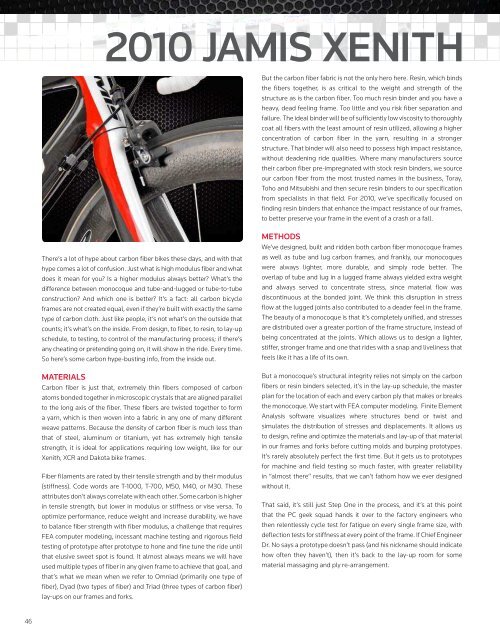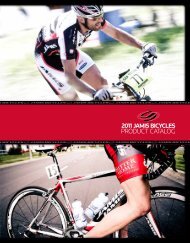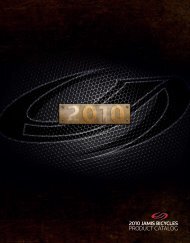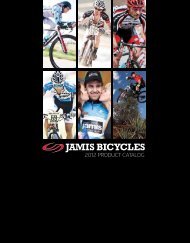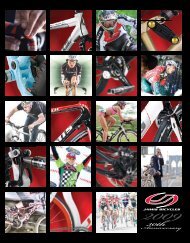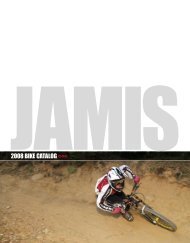You also want an ePaper? Increase the reach of your titles
YUMPU automatically turns print PDFs into web optimized ePapers that Google loves.
2010 JAMIS XENITH CARBON TECHNOLOGYThere’s a lot of hype about carbon fiber bikes these days, and with thathype comes a lot of confusion. Just what is high modulus fiber and whatdoes it mean for you? Is a higher modulus always better? What’s thedifference between monocoque and tube-and-lugged or tube-to-tubeconstruction? And which one is better? It’s a fact: all carbon bicycleframes are not created equal, even if they’re built with exactly the sametype of carbon cloth. Just like people, it’s not what’s on the outside thatcounts; it’s what’s on the inside. From design, to fiber, to resin, to lay-upschedule, to testing, to control of the manufacturing process; if there’sany cheating or pretending going on, it will show in the ride. Every time.So here’s some carbon hype-busting info, from the inside out.MATERIALSCarbon fiber is just that, extremely thin fibers composed of carbonatoms bonded together in microscopic crystals that are aligned parallelto the long axis of the fiber. These fibers are twisted together to forma yarn, which is then woven into a fabric in any one of many differentweave patterns. Because the density of carbon fiber is much less thanthat of steel, aluminum or titanium, yet has extremely high tensilestrength, it is ideal for applications requiring low weight, like for ourXenith, XCR and Dakota bike frames.Fiber filaments are rated by their tensile strength and by their modulus(stiffness). Code words are T-1000, T-700, M50, M40, or M30. Theseattributes don’t always correlate with each other. Some carbon is higherin tensile strength, but lower in modulus or stiffness or vise versa. Tooptimize performance, reduce weight and increase durability, we haveto balance fiber strength with fiber modulus, a challenge that requiresFEA computer modeling, incessant machine testing and rigorous fieldtesting of prototype after prototype to hone and fine tune the ride untilthat elusive sweet spot is found. It almost always means we will haveused multiple types of fiber in any given frame to achieve that goal, andthat’s what we mean when we refer to Omniad (primarily one type offiber), Dyad (two types of fiber) and Triad (three types of carbon fiber)lay-ups on our frames and forks.But the carbon fiber fabric is not the only hero here. Resin, which bindsthe fibers together, is as critical to the weight and strength of thestructure as is the carbon fiber. Too much resin binder and you have aheavy, dead feeling frame. Too little and you risk fiber separation andfailure. The ideal binder will be of sufficiently low viscosity to thoroughlycoat all fibers with the least amount of resin utilized, allowing a higherconcentration of carbon fiber in the yarn, resulting in a strongerstructure. That binder will also need to possess high impact resistance,without deadening ride qualities. Where many manufacturers sourcetheir carbon fiber pre-impregnated with stock resin binders, we sourceour carbon fiber from the most trusted names in the business, Toray,Toho and Mitsubishi and then secure resin binders to our specificationfrom specialists in that field. For 2010, we’ve specifically focused onfinding resin binders that enhance the impact resistance of our frames,to better preserve your frame in the event of a crash or a fall.METHODSWe’ve designed, built and ridden both carbon fiber monocoque framesas well as tube and lug carbon frames, and frankly, our monocoqueswere always lighter, more durable, and simply rode better. Theoverlap of tube and lug in a lugged frame always yielded extra weightand always served to concentrate stress, since material flow wasdiscontinuous at the bonded joint. We think this disruption in stressflow at the lugged joints also contributed to a deader feel in the frame.The beauty of a monocoque is that it’s completely unified, and stressesare distributed over a greater portion of the frame structure, instead ofbeing concentrated at the joints. Which allows us to design a lighter,stiffer, stronger frame and one that rides with a snap and liveliness thatfeels like it has a life of its own.But a monocoque’s structural integrity relies not simply on the carbonfibers or resin binders selected, it’s in the lay-up schedule, the masterplan for the location of each and every carbon ply that makes or breaksthe monocoque. We start with FEA computer modeling. Finite ElementAnalysis software visualizes where structures bend or twist andsimulates the distribution of stresses and displacements. It allows usto design, refine and optimize the materials and lay-up of that materialin our frames and forks before cutting molds and burping prototypes.It’s rarely absolutely perfect the first time. But it gets us to prototypesfor machine and field testing so much faster, with greater reliabilityin “almost there” results, that we can’t fathom how we ever designedwithout it.That said, it’s still just Step One in the process, and it’s at this pointthat the PC geek squad hands it over to the factory engineers whothen relentlessly cycle test for fatigue on every single frame size, withdeflection tests for stiffness at every point of the frame. If Chief EngineerDr. No says a prototype doesn’t pass (and his nickname should indicatehow often they haven’t), then it’s back to the lay-up room for somematerial massaging and ply re-arrangement.Once Dr. No has given his go, then it’s time for us to do the hard part ofour job. Ride! We ride and record, ride more and record more. Then wesend the frames on to our pro riders for more evaluation and comment.The process is dull, at least the part where we have to ride back to theoffice to record more is, but the beauty of carbon fiber is that it canbe so easily tuned by manual manipulation of the plies. Almost likethe head of a drum or the string of a guitar. Ride quality, the balancebetween stiffness and resiliency, the ability to feel the road, these areall attributes we’d love to be able to quantify absolutely/positively forthe geek squad so that everything that burped out of their PC’s anddownloaded into our first molds was spot on. But we’re not there yet.(And frankly, we’re kinda glad we’re not. It might mean less rides onweekdays.)The thrill of the test rides, the high technology of FEA simulationand the carbon fiber material itself often overshadows the skill andartistry of the workers who accurately apply small squares, rectanglesand triangles of carbon fiber according to the schedule our engineersassign. But it is their skill and precision that accounts in great partfor the ride called Xenith or XCR or Dakota. We don’t see their workbecause it’s hidden beneath a cosmetic layer of 1K, 6K or 12K weavethat’s hand finished for hours before it’s painted and clear coated, butit’s no less skillful and significant than the precise TIG-weld beading onour aluminum frames or the brazing work on the investment cast lugsof our steel frames.These carbon fiber swatches are laid up on a silicone mandrel, onesection of the frame at a time, with each carbon fiber ply and eachlayer of plies interwoven and overlapped so that when fully cured, themonocoque is fully unified (hence the name, monocoque). As the layupfor each section is complete, the silicone mandrel is removed, theneach section is joined to the other sections, completing the monocoque.Expandable air bladders are run through the frame, the frame is placedin a steel mold and the mold in an oven, bladders are pressurized, theoven is heated to melt and disperse the resin, and then the whole thingis cooled to harden and cure.As important as every component of this process has been so far,compaction is where it’s at as far as carbon fiber structural integrity isconcerned. If the interior design has constrictions that bind bladdersor the bladder material doesn’t sufficiently sustain air pressure, fiberwash or wrinkling in the fiber and pooling of resin is likely. Whilethis is not unusual in most carbon fiber frames today, it representsunnecessary additional weight and a possible stress riser. That’s whywe’ve taken monocoque molding technology to the next level with ourNear Net Molding technology and featured it on our 2010 Xenith SL,Xenith Team and the new Dakota dXC Team models. NNM is a patentpending process that uses both air bladders and a polystyrene preformcore that recedes as the oven heats, assuring an interior that is“near net” in finish. Meaning: an inside that is as smooth and pristineas a baby’s butt, and your assurance that every gram of resin has beencompressed, every length of fiber has been flattened and aligned.After hours of hand finishing, before heading on to the painters andclear coaters, EVERY frame is weighed to make sure it’s neither resinrich nor resin deficient. We also measure the stiffness of each framein 6 critical areas as a check on lay-up production. Each deflection testmust fall within 5% of the standards our machine and field testing haveestablished. This weighing and stiffness deflection testing guaranteesevery single frame we produce meets all <strong>Jamis</strong> manufacturing protocoland will deliver the ride qualities we defined and demand.If this is all starting to sound like the sort of hype we promised to dispel,forgive us. We know we’re on to something and we just want to shareit. If you need some credible, objective insight and feedback to verifyour Xenith claims, just check out the video review of the Xenith SL bycycling legend Frankie Andreu for Cyclist Village. Or better yet, headon down to your <strong>Jamis</strong> dealer for a test ride. It’s all hyper-bull until youclick in and put it down.46 47


